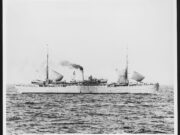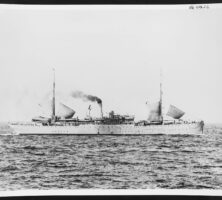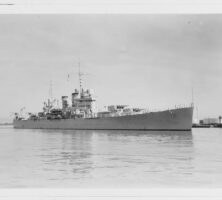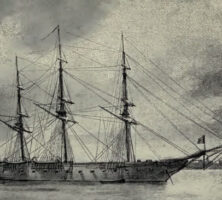Between the late eighteenth and mid-twentieth centuries, multiple ships belonging to the U.S. Navy were named Savannah. Two ships carrying the name CSS Savannah were part of the Confederate navy and are the subject of a separate article.
USS Savannah, 1799-1802
The first USS Savannah was a coastal galley constructed by John Patterson in Savannah in 1799. It was one of a few vessels commissioned by Congress to serve as naval militia training craft. The ship was designed by Joshua Humphreys and eventually came under command of Major General Charles C. Pinckney of South Carolina. After three years of use off the Georgia coast, it was sold in 1802.
USS Savannah, 1842-1870
The second USS Savannah was commissioned by the U.S. Navy as a frigate. Construction began in New York City in 1820 but was not completed until 1842 for lack of funding. Commanded by Andrew Fitzhugh, the Savannah joined the Pacific Squadron as its flagship in 1844. In preparation for the Mexican War (1846-48), the Savannah and the rest of its squadron were positioned off the coast of California. On July 7, 1846, less than two months after war broke out, the Savannah successfully took the provincial capital of Monterey without firing a shot.
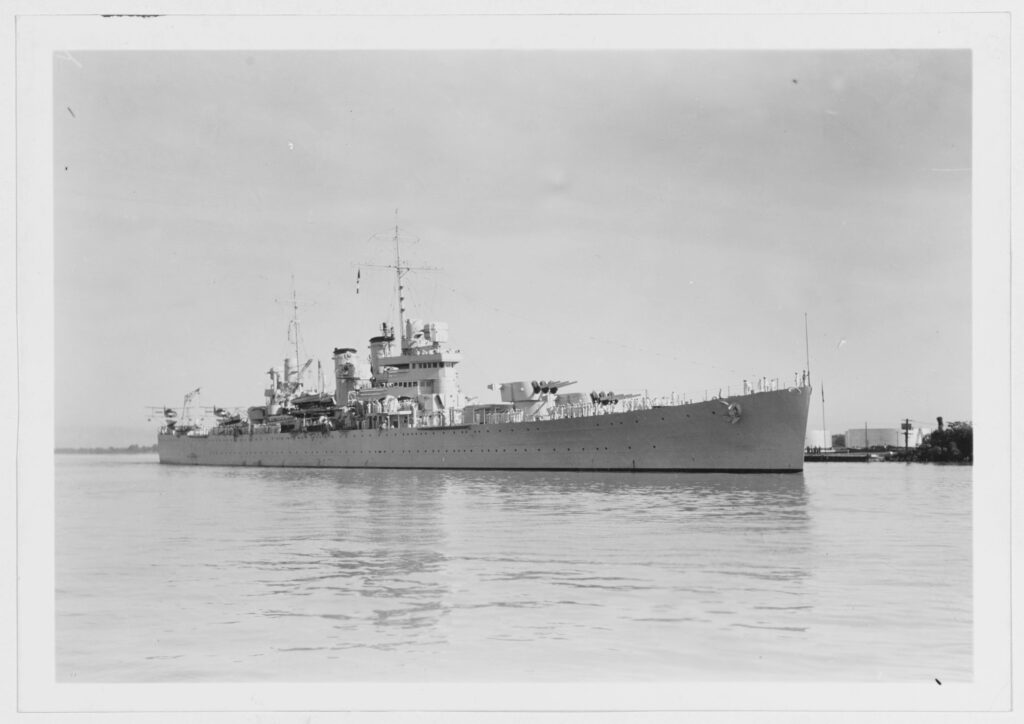
From Old Naval Days: Sketches From the Life of Rear Admiral William Radford, U. S. N. by Sophie Radford De Meissner, Wikimedia
In 1853 the vessel was assigned a three-year stint on the Brazil Station, a fleet of ships that protected American trade with Brazil and Argentina. Inactivated upon its return in 1856, the ship was then converted into a twenty-four-gun sloop of war and later served as part of a home squadron that patrolled the Gulf of Mexico. On March 6, 1860, the Savannah and the USS Saratoga participated in the “battle” of Anton Lizardo, in which they engaged and captured two Mexican ships that had been commandeered by mutineers.
During the Civil War (1861-65), the Savannah was deployed off the coast of Georgia where it helped capture two Confederate prizes—a schooner, E.J. Waterman, and a ship, Cheshire—before being taken out of active service in February 1862. For the remainder of the conflict, it served as a training ship at the U.S. Naval Academy. After the war, the Savannah continued in that capacity on transatlantic routes, until it was decommissioned in 1870. In 1883 the vessel was sold to E. Stannard and Company.
USS Savannah (AS-8), 1917-1934
The third USS Savannah was built in 1899. Originally a German commercial freighter named the SS Saxonia, the ship was seized by the U.S. Navy in Seattle, Washington, at the outbreak of World War I (1917-18). When the United States entered the war, the ship was converted to a submarine tender and renamed Savannah. It then sailed the Eastern Seaboard alongside the submarines N-1, N-2, and N-3, patrolling waters that were well-removed from the hostilities overseas.
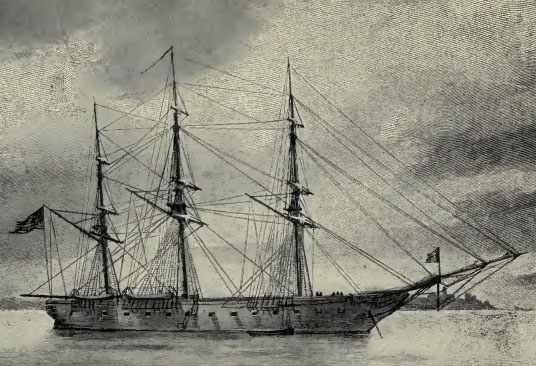
Photograph by Naval History and Heritage Command
After the war, the Savannah participated in routine patrol missions along the Atlantic, Pacific, and Hawaiian coasts while also taking an active role in torpedo testing for the navy. The third Savannah lost its name in 1933, when the same name was assigned to CL-42, a new light cruiser battleship. The third Savannah was then known as the AS-8 until 1934, when it was sold to a merchant shipping company and later renamed the Orbis.
USS Savannah (CL-42), 1937-1947
The fourth USS Savannah (CL-42) was a light cruiser that engaged in Atlantic and Mediterranean operations during World War II (1941-45). Constructed in New Jersey between 1934 and 1937, the ship completed multiple patrol trips during the late 1930s, including a visit to the Port of Savannah in 1939. It relocated to Pearl Harbor for training in 1940 and then conducted neutrality patrols off the coast of Cuba and along the Eastern Seaboard until Pearl Harbor was attacked on December 7, 1941.
Nearly a year later, the Savannah participated in its most notable effort, Operation Torch, the allied invasion of North Africa. On November 8, 1942, the cruiser opened fire on the Vichy-held Port Lyautey in Morocco in order to provide support for invading troops. The ship’s scout planes then introduced a devastating new tactic in warfare, dropping depth charges from a considerable height directly onto enemy lines. This multi-pronged barrage continued until November 11, when hostilities ended. Soon afterward, the Savannah returned to Norfolk, Virginia.
The Savannah took on many roles throughout the rest of the war, including patrols along the coast of Brazil to destroy Nazi blockade-runners, participation in the Allied invasion of Sicily and Salerno, and as part of the convoy that carried President Franklin D. Roosevelt to the Yalta Conference in Crimea. Finally, the Savannah participated in Operation Magic Carpet, the massive endeavor to bring American troops home from Europe at war’s end. The ship was officially deactivated in 1947 and was sold for scrap metal in 1966.


